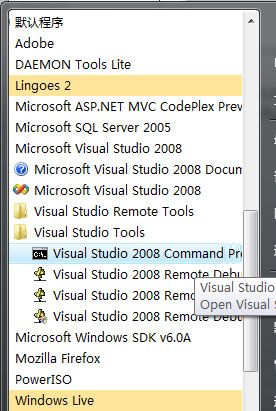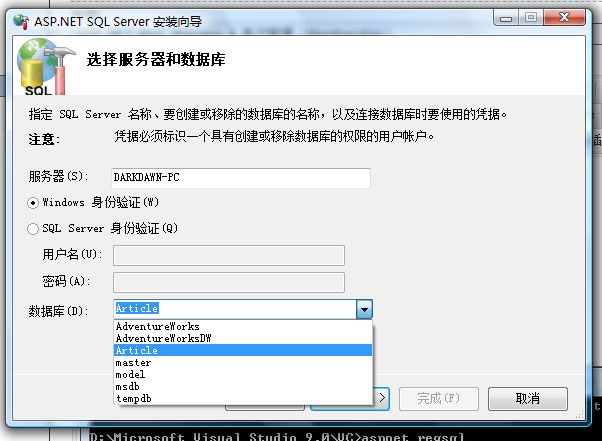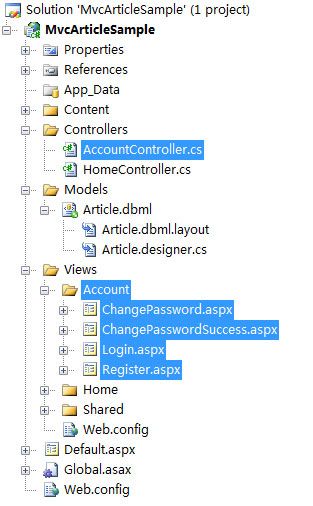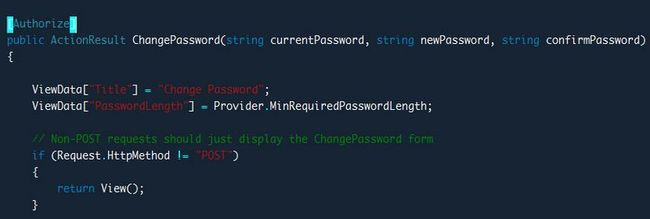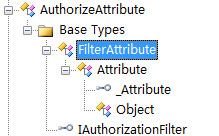ASP.NET MVC Preview 4 学习笔记 Membership Authorization
本来想写Preview 3中使用Membership的,结果Preview 4 已经集成了,真郁闷。就随便写写吧![]() 。
。
Membership的好处和不足在这里就不多说了。在中小项目中,使用它还是非常方便的。
不废话,首先运行Visual Studio 2008 Command Prompt:
输入aspnet_regsql
然后根据向导:
选择数据库:
然后一路下一步,完成向导,这时候数据库中就已经有了Membership所需要的表、视图和存储过程。
记得修改web.config文件。用这个数据库的ConnectionString代替默认的SqlExpress的。就可以正常使用了。
ASP.NET MVC PREVIEW4把Membership的使用已经集成了,并且做了默认的Controller和Views:
首先看看注册用户部分的代码:
1
public
ActionResult Register(
string
username,
string
email,
string
password,
string
confirmPassword)
2 {
3
4 ViewData[ " Title " ] = " Register " ;
5 ViewData[ " PasswordLength " ] = Provider.MinRequiredPasswordLength;
6
7 // Non-POST requests should just display the Register form
8 if (Request.HttpMethod != " POST " )
9 {
10 return View();
11 }
12
13 // Basic parameter validation
14 List < string > errors = new List < string > ();
15
16 if (String.IsNullOrEmpty(username))
17 {
18 errors.Add( " You must specify a username. " );
19 }
20 if (String.IsNullOrEmpty(email))
21 {
22 errors.Add( " You must specify an email address. " );
23 }
24 if (password == null || password.Length < Provider.MinRequiredPasswordLength)
25 {
26 errors.Add(String.Format(CultureInfo.InvariantCulture,
27 " You must specify a password of {0} or more characters. " ,
28 Provider.MinRequiredPasswordLength));
29 }
30 if ( ! String.Equals(password, confirmPassword, StringComparison.Ordinal))
31 {
32 errors.Add( " The password and confirmation do not match. " );
33 }
34
35 if (errors.Count == 0 )
36 {
37
38 // Attempt to register the user
39 MembershipCreateStatus createStatus;
40 MembershipUser newUser = Provider.CreateUser(username, password, email, null , null , true , null , out createStatus);
41
42 if (newUser != null )
43 {
44
45 FormsAuth.SetAuthCookie(username, false /* createPersistentCookie */ );
46 return RedirectToAction( " Index " , " Home " );
47 }
48 else
49 {
50 errors.Add(ErrorCodeToString(createStatus));
51 }
52 }
53
54 // If we got this far, something failed, redisplay form
55 ViewData[ " errors " ] = errors;
56 ViewData[ " username " ] = username;
57 ViewData[ " email " ] = email;
58 return View();
59 }
2 {
3
4 ViewData[ " Title " ] = " Register " ;
5 ViewData[ " PasswordLength " ] = Provider.MinRequiredPasswordLength;
6
7 // Non-POST requests should just display the Register form
8 if (Request.HttpMethod != " POST " )
9 {
10 return View();
11 }
12
13 // Basic parameter validation
14 List < string > errors = new List < string > ();
15
16 if (String.IsNullOrEmpty(username))
17 {
18 errors.Add( " You must specify a username. " );
19 }
20 if (String.IsNullOrEmpty(email))
21 {
22 errors.Add( " You must specify an email address. " );
23 }
24 if (password == null || password.Length < Provider.MinRequiredPasswordLength)
25 {
26 errors.Add(String.Format(CultureInfo.InvariantCulture,
27 " You must specify a password of {0} or more characters. " ,
28 Provider.MinRequiredPasswordLength));
29 }
30 if ( ! String.Equals(password, confirmPassword, StringComparison.Ordinal))
31 {
32 errors.Add( " The password and confirmation do not match. " );
33 }
34
35 if (errors.Count == 0 )
36 {
37
38 // Attempt to register the user
39 MembershipCreateStatus createStatus;
40 MembershipUser newUser = Provider.CreateUser(username, password, email, null , null , true , null , out createStatus);
41
42 if (newUser != null )
43 {
44
45 FormsAuth.SetAuthCookie(username, false /* createPersistentCookie */ );
46 return RedirectToAction( " Index " , " Home " );
47 }
48 else
49 {
50 errors.Add(ErrorCodeToString(createStatus));
51 }
52 }
53
54 // If we got this far, something failed, redisplay form
55 ViewData[ " errors " ] = errors;
56 ViewData[ " username " ] = username;
57 ViewData[ " email " ] = email;
58 return View();
59 }
首先是判断在页面没有提交的时候,输出视图;
然后根据提交的内容,做了一大堆验证,错误信息存储在List<string> errors里面;
然后创建用户,并登录。
这个基本上改改视图就可以直接用了,默认的视图:
再看看登录的Controller Action:
public
ActionResult Login(
string
username,
string
password,
bool
?
rememberMe)
{
ViewData[ " Title " ] = " Login " ;
// Non-POST requests should just display the Login form
if (Request.HttpMethod != " POST " )
{
return View();
}
// Basic parameter validation
List < string > errors = new List < string > ();
if (String.IsNullOrEmpty(username))
{
errors.Add( " You must specify a username. " );
}
if (errors.Count == 0 )
{
// Attempt to login
bool loginSuccessful = Provider.ValidateUser(username, password);
if (loginSuccessful)
{
FormsAuth.SetAuthCookie(username, rememberMe ?? false );
return RedirectToAction( " Index " , " Home " );
}
else
{
errors.Add( " The username or password provided is incorrect. " );
}
}
// If we got this far, something failed, redisplay form
ViewData[ " errors " ] = errors;
ViewData[ " username " ] = username;
return View();
}
{
ViewData[ " Title " ] = " Login " ;
// Non-POST requests should just display the Login form
if (Request.HttpMethod != " POST " )
{
return View();
}
// Basic parameter validation
List < string > errors = new List < string > ();
if (String.IsNullOrEmpty(username))
{
errors.Add( " You must specify a username. " );
}
if (errors.Count == 0 )
{
// Attempt to login
bool loginSuccessful = Provider.ValidateUser(username, password);
if (loginSuccessful)
{
FormsAuth.SetAuthCookie(username, rememberMe ?? false );
return RedirectToAction( " Index " , " Home " );
}
else
{
errors.Add( " The username or password provided is incorrect. " );
}
}
// If we got this far, something failed, redisplay form
ViewData[ " errors " ] = errors;
ViewData[ " username " ] = username;
return View();
}
和注册大同小异。
最后看看修改密码的Action,前面加了个Attribute:[Authorize],限制访问用户必须是已登录用户。
唉,啥都弄好了,叫俺以后咋混啊:
仍然是一个FilterAttribute,可以指定Roles和Users,![]() ,俺以前也写过一个类似的,看来得废掉了。
,俺以前也写过一个类似的,看来得废掉了。
注册、登录、验证还可以稍微改进,比如加进验证码、AJAX等等特性。
初看了一下,算是学习笔记吧,明天读读源代码,再写写心得。
